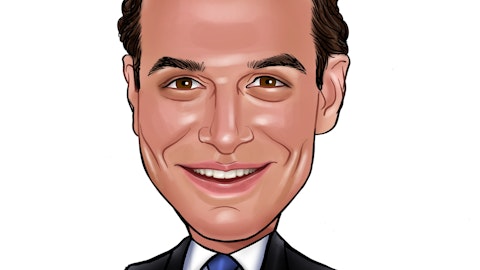Moving to the balance sheet. As of July 31, 2023, we had $4.1 million of cash on hand compared to $6.6 million at January 31, 2023. Under the Avelead acquisition agreement, the company has contracted to provide additional consideration on each of the first to twelve monthly anniversaries of the closing date. The first of these payments were paid in the fourth quarter of fiscal 2022. The second payment will be paid in cash and stock and is valued on the balance sheet at approximately $3 million. Of this amount, it is estimated that we will pay $1.2 million in cash on — in November 2023. The liability is referred to as acquisition earn-out liability on the company’s balance sheet. The company’s accounts receivable was $2.8 million at July 31, 2023, substantially lower than January 31, 2023.
The lower accounts receivable is partially attributable to recently implemented eValuator contracts with performance guarantees that are not invoiced until the guarantee is met. The company has historically met these guarantees within two to three months of implementation. The balance of our term loan as of July 31, 2023 was $9.5 million. As of September 1, 2023, we are in the third 12-month period of the loan and will make $1 million of principal payments over the course of the next 12 months. We have access to a $2 million line of credit, which we can draw if necessary. Based on our current forecast, we may need additional financing to fund our ongoing operations without sacrificing future growth. Our current bank debt of $9.5 million is approximately 0.5 times our annual recurring revenue or ARR.
We believe the industry average debt to ARR ratio for companies similarly situated to ours is 1 to 1.25. This gives us some $10 million in debt capacity if refinanced. We believe that the venture-backed credit markets are improving, and we could successfully refinance our bank debt with a credit facility in the range of 1.0 times to 1.25 times ARR. On its current cost structure, we believe our overall business will achieve adjusted breakeven at a SaaS revenue rate of $17 million. We achieved this level of bookings in Q4 of 2022 and expect to have this revenue fully implemented during the third quarter of 2023. The company is realizing incremental SaaS gross margins above 80%. I am proud of the progress this company continues to make and want to commend our staff.
That concludes my comments. I will now turn the call back to Tee Green for his closing remarks. Tee?
Tee Green: Thank you, Tom. We continue to enable health care providers to proactively address revenue leakage and improve financial performance and have taken major steps forward to drive reoccurring revenue streams that better position our company for growth and to deliver significant shareholder value over the long-term. While the macro environment remains more challenging than previously expected, we see strong demand for our prebuild revenue cycle methodology and our solutions. We believe our ability to be self-sustaining and generate cash from operations is a significant next step in our life cycle. I am proud of our team for making the necessary changes and executing on this milestone for our business. Before we begin our Q&A session, I’d like to thank the entire Streamline team once again for all the hard work and dedication.
Their contributions are essential for us to support our health care providing clients and ensure they have the necessary tools to free up time and resources to provide quality care for the communities they serve. Thank you all for your support of Streamline Health and our vision. Now I’d like to open the call up to your questions. Operator?
Operator: Thank you. We will now be conducting a question-and-answer session. [Operator Instructions] Our first questions come from the line of Matt Hewitt with Craig-Hallum. Please proceed with your questions.
Matt Hewitt: Good morning and thank you for taking the questions. Maybe first off, I’d like to dig in a little bit more on the current selling environment. Obviously, you commented a little bit on some of the challenges that you’re seeing. I know you had a 2.5 year period with COVID weighing on hospital’s decision-making process. We started to see this spring, we started to see some of the procedure volumes improving which I think expectations were that you would see some of that increased revenue flowing to software and equipment purchases and whatnot. But what — where are we right now? I mean, if hospitals are seeing a little bit of improvement there, what’s kind of the gating factor to kind of the lift off that I think many are expecting as we get through this fiscal year for you guys?
Tee Green: Yes, Matt, thanks. This is Tee here. Yes, it’s — can you hear me okay?
Matt Hewitt: Absolutely.
Tee Green: Okay, good. Yes. I mean the first half of ’23 has been fairly slow, I think, industry-wide. The coming out of the administration’s office when I mean the CFO and legal, those seem to have been starting to fall or make its way through the pipeline. I think IT we still have some real struggles, getting the priority in the IT departments, but that’s even beginning to thaw as well. If you look at Q2, we did four transactions, which is really, really encouraging. They were smaller, they weren’t maybe average like 130 ACV. One of them was with Oracle, though is super encouraging because, we had this relationship with Cerner, and then we all know what happened and it’s taken four or five months for all of the management and the strategy to shut themselves out.


